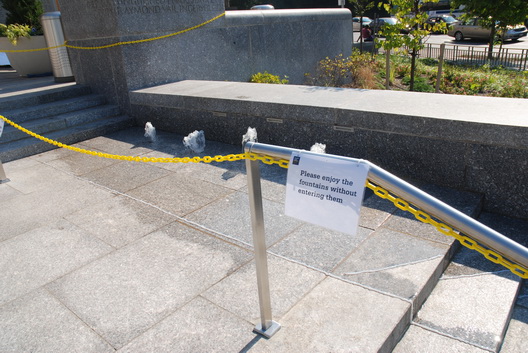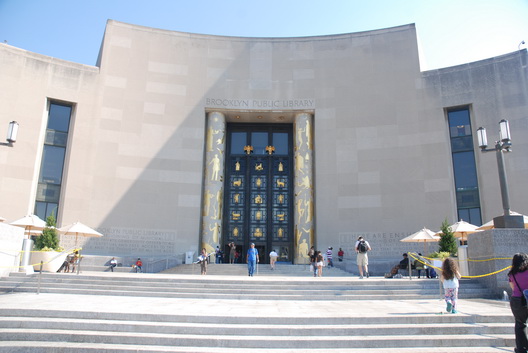Brooklyn Public Library Fountains Popular

We finally paid a visit to the recently completed new plaza in front of the Brooklyn Library. It's pleasant, although it looks like it could use more greenery in order to prevent it from become a sun-reflecting frying pan in the summer. We are not trying to nitpick, but we couldn't help notice that the new fountains that were installed must have proven popular with both adults and children as they had to be chained off and signs had to be put up telling people to stay out. Again, we wonder what the designers might have been thinking to install bubbling water in an expanse of stone and concrete in the middle of Brooklyn and not expect people to walk through them? It rather reminds us of the way the fountain in front of the Brooklyn Museum was barricaded and put under guard when the museum first opened because people were, well, playing in the fountain. It reminded us of our belief that architecture and planning students should be required to take a full year course called "Travel the City and Watch How People Actually Use Things." All that having been said, it's a nice space.


Labels: Grand Army Plaza, Urban Planning

3 Comments:
It is probably true that institutions are emphasizing aesthetics over fun, but it is definitely true that there is a health reason for rules prohibiting playing in fountains. The water is recirculated without any treatment and can lead to nasty infections. In fact, as a swimmer, I am a bit concerned by comments by some doctors that they would never let their families use a public hot tub or pool--where the water is allegedly treated.
okay, sure. maybe playing in the fountains is a bad idea (sure was fun, though), and likely it's a slip-and-fall liability, but since everyone knows that, why not design a barrier in the first place? this is not rocket science.
The fountains are still undergoing a testing phase. Hopefully at the end of the testing phase we will be able to eliminate the yellow chains and give people access to the fountain the way they were originally intended and designed. At that point a general sign with conduct rules on the plaza will post guidelines also for the use of the fountains.
Unfortunately we are approaching the end of the fountain season while all this is going on, but the goal is to work out all the bugs before the fountains need to be turned off for winter. This is a lengthy process because many different trades were involved in building this fountain, such as concrete, stone masons, plumbers, electricians, fountain engineers, architects, construction manager etc., so please bear with us. This type of fountain does not allow for much tolerances during construction, in this case we needed to re-engineer proper drainage and prevent it from spilling out to the side walk.
Most fountains are custom designed and custom built. If compared to car design for example, each fountain is a prototype and there is only one chance to get it right. Considering the long process from planning to completion of construction ( 7 years in this case) it is pretty amazing how close this came to the original intention.
It is true that the water is recirculated ( most fountains hopefully are) but be assured that the water IS treated through a controlled process and is safe, but it is not potable water, Normally one does not drink the water from a swimming pool or a fountain.
While I respect that some people have problems being exposed to the water from a public fountain I hope that they will be tolerant enough to let others enjoy them at there own leisure.
Post a Comment
<< Home